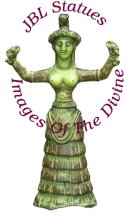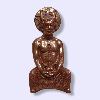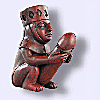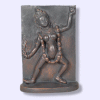|

HOME
|
|
Tantra Sacred Sexuality and Earth-Healing
|
At once the most sacred and the most mysterious path to higher consciousness, Tantra refers to the Divine Union of Opposites. Taoists refer to these energies as yin (from yoni, the active principle) and yang (the recumbent principle). Bly, Nin, and Jung tell us that each individual must achieve inner marriage of their masculine and feminine natures to encounter true equipoise.






|
Hindu consort pair images epitomizing this psychic symbolism are superb representations of the social, sexual and spiritual interconnectedness of women and men. They include Shiva/Shakti (Yabyum), Laxshmi/Vishnu, Rhada/Krishna, Sita/Rama, Kali/Shiva, and Shiva Ardanariswara. A variation of this sense of sacred marriage was present in the ancient Western tradition. The images of Vesta/Pales, Freya/Frey, Morrigan /Dagda, Rosmerta/Lugh, Ariadne/Minotaur, and Isis/Osiris all express Tantra, human sexuality aligned with the fertility energies of universal creation.
Kept secret by Western church fathers, Tantra promotes male and female coital energies in achieving emotional, spiritual, and physical harmony. Tantra images help us to extend this sense of balance out toward all of creation, both animate, and inanimate. Charles and Carolyn Muir offer an excellent discussion of practicing Tantric maithuna in love relationships.
Sacred Sexuality, Sacred Earth
What would the implications be if our world today viewed sexuality as sacred? In fact, this condition probably did exist in late Neolithic and early historic times in Western cultures as well as Eastern.
Ample archeological remains suggest that when the earth is viewed as sacred by an entire culture, sexuality figures at the core of religious ritual, and social structure is organized to highly respect the feminine. It is very likely that such systems prevailed in ancient Sumer, Babylonia, Canaan, Anatolia, pre-dynastic Egypt, Crete and Myceanean Greece.
Let us imagine for a moment the outlines of how such a political and social system might operate in, for example, ancient Babylonia.
The seasonal reproductive cycle of the Great Earth Mother would be venerated as the source of all love, all renewal, all creative growth, all that sustains human life. Large communal rituals to propitiate and re-sanctify Earth Mother's bounty would occur periodically. (Harvest festivals that survive world-wide today are remnants of such celebrations.)
In microcosm such earth-honoring cultures were matrifocal, with elder women in every extended family accorded the most respect, honor and authority. Male respect and authority would emanate from two channels: 1) as a result of relationship (as brothers, sons or other kinship ties) to honored women; and 2) as a result of accomplishments, especially those connected with agricultural skill or service to community.
In such a world the most spiritual act an individual woman might engage in would be periodic (seasonal, and at least yearly) service as one of many priestesses in the temple of the Great Goddess. Among her priestess roles, none would be more important than re-enacting the Great Rite of sacred sexuality in order to keep the Earth Goddess fertile, receptive and benevolent.
In like token, the deepest devotional offering of male agricultural workers would involve a seasonal tithing of first fruits to the Goddess. From such "tenth parts" of the entire society's harvests would come the source of material richness and comfort of the temple, its Priestess Queens, and the culture as a whole.
Family lineage would be matrifocal, with children absolutely certain of their maternal ancestry and far less focused on the paternal. The exact father of a given child would always remain uncertain because sexuality would occur within the context and mystery of the sacred.
Picture the priestess at night in darkened temple rooms offering her body, with the most sacred, respectful and tender motivations imaginable, as a representation of Holy Mother Earth herself. Picture the farmer, his heart and his senses perhaps stimulated by droughts of sacred barley beer or wine. He enters the pitch-black chamber, and with a reverence at once primevally wild and mystically celebratory, he plants his seed, with Hossanahs of both physical and spiritual ecstasy, in the very body of his beloved Mother Earth.
Imagine the rich variety of feelings and concepts that would be central in such societies: storms, passion, changes, seeds, cycles, cleansing, renewal, fertility, power, softness, creativity, wholeness!
For many millennia, and across cultures, children were born out of these penultimately sacred rites. Their very conceptions a result of holy ritual, imagine how they were cherished and cared for within such cultures!
Circa 5000 B.C.E. a paradigm shift occurred wherein herdsmen, skilled in the use of sharp blades for animal slaughter, infiltrated and took control of agriculture-based societies. First among their objectives would be the justification of their methods for power-grabbing.
Ancient scriptures and rituals venerating the Great Mother would be re-written. Cain and Abel-type myths would demonize agriculture-centered systems and sacralize animal slaughter as the politically correct invocation to a newly masculinized concept of the Divine.
Over the next 6000 years the process of "taking dominion over" the earth would replace the concept of sacred stewardship of a Holy Mother. Sexuality would evolve from a sacred, venerative function into a power/ownership-of-children function.
The profound psycho-emotional gifts of the feminine would become captive also. And the vibrant, celebratory, and periodic sexual energies of women would become associated with temptation, shame and uncleanliness.
Thus the genesis of some false myths we today have inherited. Because the serpent is the most ancient and widespread archetypal expression of feminine wisdom and sacred sexuality, it became the central image for condemnation and eradication.
By 3600 B.C.E., as the new myths came about, the sexual and serpent energies of woman were associated with guilt, unworthiness and deprivation of access to the Divine. In the Near East, priestesses of the sacred Goddess were re-mythed as prostitutes, Great Whores of Babylon.
In the Mediterranean the triple goddess of feminine power and wisdom was re-mythed as serpent-haired Medusa. The fact that her fierce glance turned men -- not humans, but males -- to stone is nothing more than the literal admission, within the myth itself, both of outrage at the violation of the old earth religion and the accompanying numbing of emotion required of the men engaged in that violation. In this sense Goddess Medusa is an archetype whose return in our own times is vital.
Of course the generative powers of Mother Earth could never be fully appropriated by patriarchal culture; well into historic time rituals, shrines and pilgrimages to the goddess were maintained. As recently as the Dark Ages however, male St. Patricks have driven serpent energies out of cultures. Medieval St. Georges have slain the very dragons which, ironically, were among the objects of sacred mystical quests by generations of white knights, longing to re-unite with the fruitful and balancing energies of the sacred feminine.
The demonization of sacred sexuality is with us still, yet we are finally shaking free of its repressive yoke. Let us restore the wisdom of Tantra, the sacred kundilini serpent of our own inner divine flame, to the center of our daily life, finding ways to teach these mysteries to our children and to venerate the archetypes that give expression to these forces.
Central among these archetypes are: Inanna, Ishtar, Astarte, Asherah and Baal, Isis, Horus and
Osiris, Ariadne and Dionysos, Cybele, Frey and Freya, Morrigan and Dagda, Shiva and Shakti, and many others re-created by Sacred Source.






